Eclipsing Binaries
A binary star is a system of two stars that orbit around their center of mass. In an eclipsing binary, the orbit is aligned so that one star passes in front of the other along our line of sight. This causes a periodic dimming in light as the stars pass in front of each other. The CHARA Array can study eclipsing binaries by spatially resolving the component stars.
Epsilon Aurigae
Astronomers used the CHARA Array to image the eclipse of the star Epsilon Aurigae by its mysterious, less luminous companion star. Epsilon Aurigae has been known since 1821 as an eclipsing double star system, but astronomers have struggled for many decades trying to decipher the clues to what was causing these eclipses, which happen every 27 years. The images of the eclipse in 2009-2010 largely settle the matter: the eclipse is caused by a disk of material, probably similar to the state of our solar system 4.5 billion years ago as the planets began to form around our own infant sun.
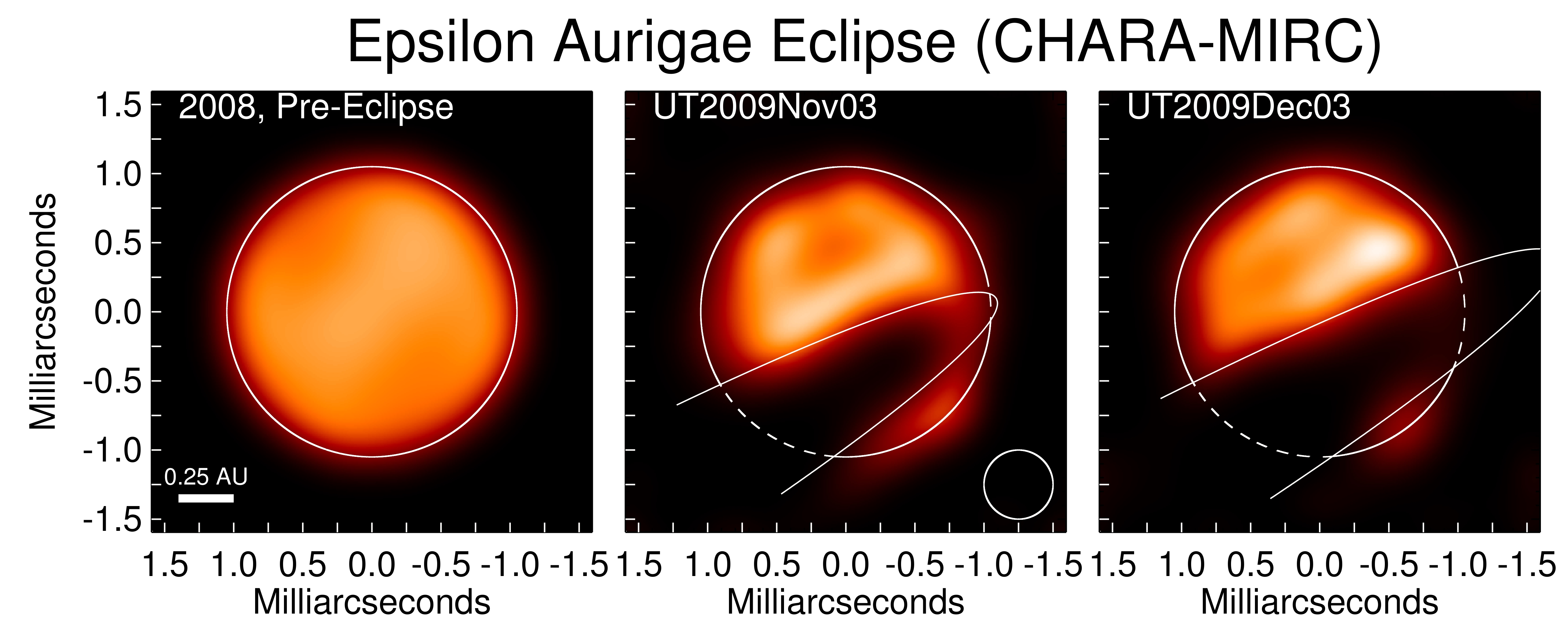
The images of Epsilon Aurigae show the intrusion of an apparently wedge-shaped structure across the face of a huge star, nearly 150 times the size of our sun. The images of the star and wedge-shaped structure show the direct motion over the course of the eclipse, yielding a measurement of the relative masses of the components. The primary star itself is thought to be in a very interesting phase of its own evolution, turning out to be less massive than the eclipsing disk and the star hidden at the center of that disk.
Because astronomers hadn't observed much light from the faint companion, the prevailing opinion labeled it a smaller star orbited edge-on by a thick disk of dust. The theory held that the disk's orbit must be in precisely the same plane as the dark object's orbit around the brighter star, and all of this had to be occurring in the same plane as Earth's vantage point. This would be an unlikely alignment, but it explained observations. The CHARA images show that this is indeed the case. A geometrically-thin, dark, dense, but partially-translucent cloud can be seen passing in front of Epsilon Aurigae.

References:
Kloppenborg et al. 2010, Nature, 464, 870
Kloppenborg et al. 2015, ApJS, 220, 14
Beta Lyrae
Beta Lyrae is an interacting and eclipsing binary where material is gravitationally pulled away from one star and accretes on to the surface of the companion. The system has an orbital period of 13 days. Using the CHARA Array, researchers obtained images of beta Lyrae showing the mass donor and the thick disk surrounding the mass gainer. The donor is brighter and appears elongated; this is the first direct detection of photospheric tidal distortion due to Roche lobe filling. The disk component is fainter and more elongated than the donor.
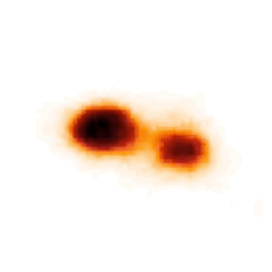
Reference:
Zhao et al. 2008, ApJ, 684, 95
Algol
Algol is a hierarchical triple system. The inner pair has an orbital period of 2.87 days. Mass is being transferred from the sub-giant secondary to the main-sequence primary in the inner binary. Astronomers used the CHARA Array to map the orbits of the inner and outer pairs and to measure the angular sizes and mass ratios of the three components. The inner and outer orbits are nearly perpendicular.
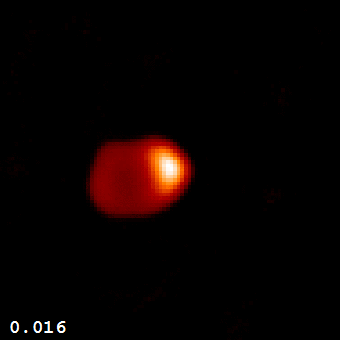
Reference:
Baron et al. 2012, ApJ, 752, 20
Binary Orbits and Dynamical Masses
Binary stars are bound in orbit through their gravitational attraction. Mapping the orbital motion their provides a way to measure the masses of the component stars. The CHARA Array has the power to resolve the visual orbits of short period spectroscopic binaries.
Sigma Orionis
The multiple star sigma Orionis is located just south of the eastern most star in Orion's belt. It consists of a close binary with an orbital period of 143 days, a tertiary component with a period of 160 years, and three more distant companions. The most massive component in sigma Orionis is the brightest star in a cluster of several hundred young stars with ages of only 2-3 million years old. Many of the young stars in the cluster are still surrounded by disks of gas and dust where planets form.
Using the MIRC beam combiner at the CHARA Array, the position of the close binary, sigma Orionis Aa,Ab, was resolved on nine nights between 2010-2013. The visual orbit has a semi-major axis of only 4.3 mas; resolvable only though interferometric techniques. The combination of the relative visual orbit with previously published radial velocities measured from the Doppler shift of spectral lines as the stars move around their center of mass (Simón-Díaz et al. 2015, ApJ, 799, 169), provides high precision dynamical masses of 17.0 +/- 0.2 Msun for Aa and 12.8 +/- 0.2 Msun for Ab. These mass measurements can be used to improve models of stellar evolution for stars much more massive than the sun.
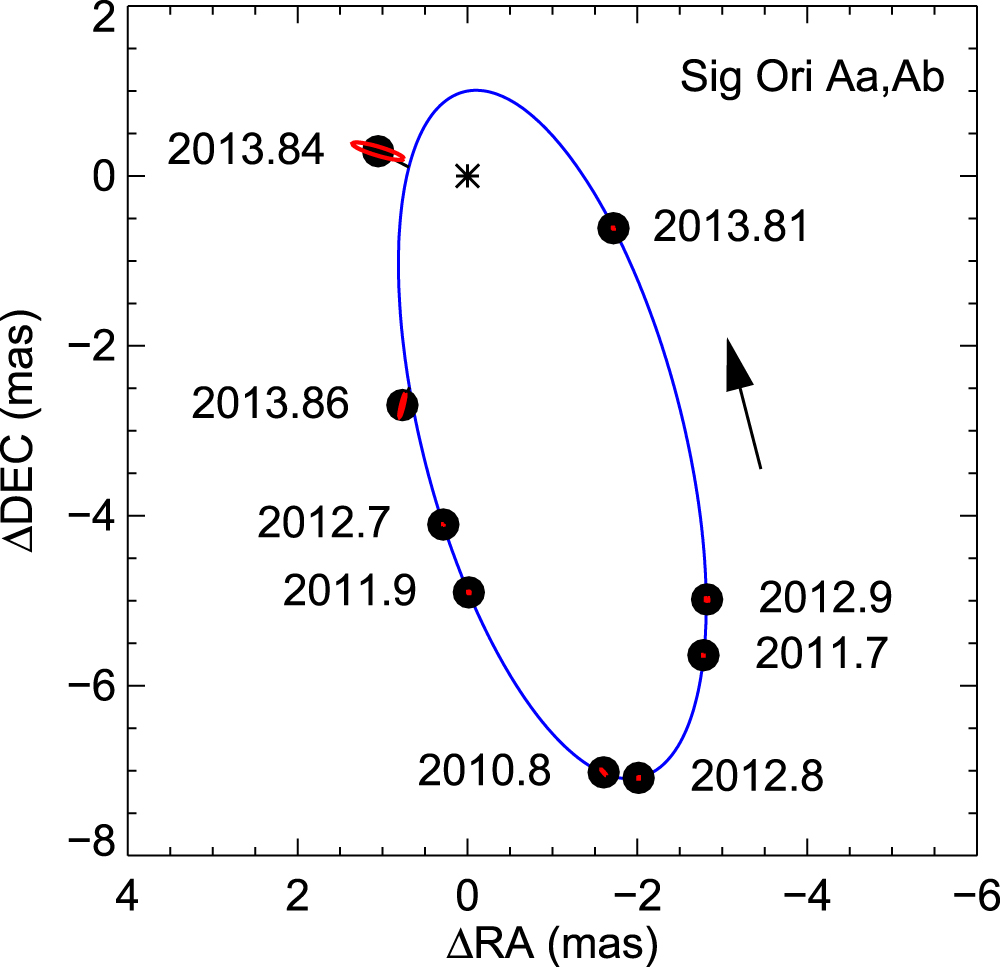
Binary stars also provide a unique way to measure astronomical distances. By comparing the angular scale of the visual orbit with the physical scale of the spectroscopic orbit, the "orbital parallax" of the system places sigma Orionis at a distance of 387.5 +/- 1.3 pc. With a precision of better than 1%, this is the most precise distance measured to a star in the young sigma Orionis cluster. Previous distance estimates ranged from 330 to 450 pc (e.g., Walter et al. 2008). This will help characterize the physical properties of stars in the region, improve our knowledge of the age of the cluster, and help establish the lifetime of circumstellar disks and the timescales for planet formation.
Comparison of the orientation of the inner and outer orbits in the triple show that the two orbits are not coplanar, with a relative inclination of ~ 120-127 deg. The orbital motion of the inner pair is prograde (in the direction of increasing position angles), while the motion of the outer pair is retrograde.
Reference:
Schaefer et al. 2016, AJ, 152, 213
High Contrast Companions
Using the precision closure phases measured with the MIRC beam combiner, the CHARA Array is sensitive to detecting faint companion down to ΔH < 6 mag with separations ranging from 0.5 mas out to 50 mas in the near-infrared H-band (Gallenne et al. 2015).
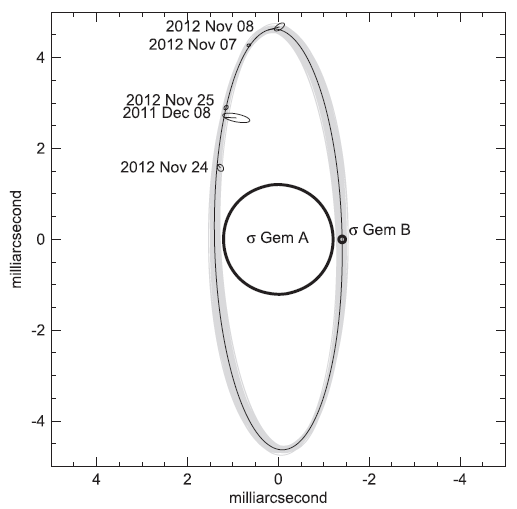
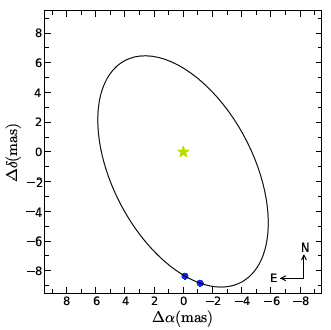
References:
Gallenne, A., et al. 2013, A&A, 552, A21
Gallenne, A., et al. 2015, A&A, 579, A68
Roettenbacher, R. et al. 2015, ApJ, 807, 23
Roettenbacher, R. et al. 2015, ApJ, 809, 159



